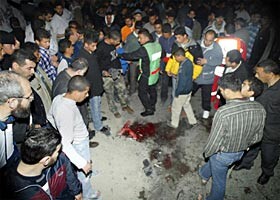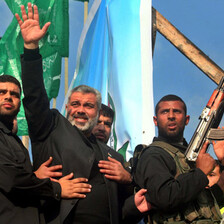The Electronic Intifada 22 March 2004

One of Al-Jazeera’s images of the assassination aftermath. Click here to view Al-Jazeera’s slideshow.
This, the second assassination attempt on the 66-year-old Yassin, was successful. Pictures released by the Al-Jazeera satellite channel show the grisly results of the missiles and Palestine’s streets are once again on fire.
In a statement this morning by a spokesman for the Israeli Defense Forces, Israel claimed that “Yassin, who was personally responsible for numerous murderous terror attacks, resulting in the deaths of many civilians, both Israeli and foreign, was killed in the attack.”
The Israeli Ministry of Foreign Affairs, Israeli Defense Forces [sic], and their network of supportive pro-Israeli lobby groups around the world swung into action, churning out — at a very early hour — talking points for use by pro-Israeli media activists, web pages with audio files of parts of Yassin’s speeches, and early analysis of aspects of Western media coverage of the assassination. It was quite a production, and pointed to a considerable amount of planning on Israel’s part which reflects the country’s concerns about how its assassination policy is received around the world.
The obvious point to make is: if Yassin was responsible for planning attacks on civilians then — like anyone who attempts to use us civilians as their latest gory political billboard advertisement — he deserved to be tried, convicted, and sentenced for his crimes.
It is irony of the highest level that the very process by which Yassin was killed may place Israel in the dock one day to answer questions about its own crimes against humanity.
Israel’s “targeted killings” as it likes to refer to its firing of missiles from combat helicopters and aircraft into crowded civilian areas, are a blatant form of state terrorism, to say nothing of their affront to the English language.
According to PCHR, between 29 September 2000 and 3 March 2004, Israel killed 337 Palestinians in “targeted killings”.
Of this number, as many as 134 of those killed (or 40 percent) were civilian bystanders, including many women and children.
Israel’s two assassination attempts against Yassin
The first Israeli assassination attempt against Yassin took place on 6 September 2003. At 4pm in the afternoon, an Israeli aircraft fired a single missile into the third floor of a residential apartment building in the center of Gaza City. Sheikh Yassin and Ismail Haniya, another HAMAS leader, both sustained moderate injuries in the attack.
In addition, thirteen Palestinian civilians, including 6 children, were injured. The apartment building suffered severe structural damage and several nearby buildings were also damaged.
Today’s attack demonstrated a similar disregard for civilians. PCHR fieldworkers described the events as follows:
Sheikh Yassin was traveling on his wheelchair accompanied by 3 bodyguards, when one of the missiles directly hit Sheikh Yassin and his bodyguards.The other two missiles exploded in the surrounding area and killed 4 other civilians. In addition to those killed, 17 civilians were injured, including Sheikh Yassin’s two sons: ‘Abdul Hamid, 33; and ‘Abdul Ghani, 29.
Four children were among those injured. ‘Abdul Hamid and 5 of the injured remain in serious condition. All of the casualties were worshippers who had just left the mosque following the dawn prayer. The other 7 victims killed were identified as:
1. Mo’men Ibrahim al-Yazouri, 28;
2. Rateb ‘Abdul Rahman al-‘Aloul, 35;
3. Khamis Mushtaha, 32;
4. Ameer Ahmed ‘Abdul ‘Aal, 25;
5. Rabi’ ‘Abdul Hai ‘Abdul ‘Aal, 18, a bodyguard of Sheikh Yassin;
6. Ayoub Ahmed ‘Atallah, 26, a bodyguard of Sheikh Yassin;
7. Khalil ‘Abdul Elah Abu Jayab, 30, a bodyguard of Sheikh Yassin.
The majority of those killed and injured this morning were worshippers coming out of a mosque. Surely there can be no mistaking the obvious premeditated intent behind firing rockets from a combat helicopter into crowds of worshippers exiting a holy site in a densely-populated civilian neighbourhood? This is nothing less than Israel’s version of a bus bombing and the civilian casualties prove it.
Obvious dynamics
In such an entrenched situation as the Israeli-Palestinian conflict, which has been endured for over half a century, there can be no claims of ignorance to the existence of certain dynamics. For decades, Israel has been killing Palestinian leaders from a variety of factions with predictable results, even with factions who had never traditionally shown an interest in suicide bombings:
“Following the death of local Tanzim leader Raed Karmi on January 14, 2002, the Fatah changed its modus operandi from shooting attacks on roads to suicide bombings in Israeli cities, and terrorist attacks against IDF checkpoints.”
This quote (emphasis added) originates from an Israeli Defence Forces document no less — “Ramallah as a Center of Terror: Background Information”, IDF Spokesman, 12 March 2002 — fails to note one key aspect, that Ra’ad Karmi did not merely “die”.
Karmi was killed in a roadside bomb that was widely assumed to be an Israeli assassination. A few months earlier, in September 2001, Israel launched a missile attack on his car in which two others were killed. Mark Lavie, in “Israel Rethinking Targeted Killings” (Associated Press, 4 February 2002), noted that:
His death had been preceded by more than a month without Israeli civilian deaths - the longest such period since fighting erupted in September 2000 - and it swiftly put an end to the lull; 11 Israelis and an American died in a string of revenge attacks.
In a September 2003 analysis on EI, professor of international politics and Middle East Studies Steve Niva noted that:
“The escalation of these assassinations illustrated by the August 22 assassination of the major Hamas spokesman Ismail Abu Shanub in Gaza, widely seen as a Hamas moderate, is a clear sign that the Sharon government is concerned more about its own extremist political agenda than it is for Israeli civilian lives.”[1]
Niva’s article is worth reading as it highlights repeated historical examples of periods of calm shattered by Israeli provocation followed by a predictable Palestinian retaliation.
The large number of incidents in which an assassination was followed by a terrorist attack does not leave Israel much leeway to claim that it is unaware what events such as this morning’s killing of Yassin will result in. One is left to conclude that its assassination policy at some level is intended to encourage the minority of Palestinians who are predisposed to commit atrocities against Israeli civilians to provide an abundance of fresh distractions from Israel’s own relentless and violent colonisation. From the beginning of January until March 21st, 151 Palestinians have been killed and 864 injured by Israel.[2] 37 Israelis were killed in terrorist attacks from the beginning of the year until March 14th.[3]
Media coverage
This morning’s assassination of Yassin was widely reported around the world. Yet the key aspect of the story — the civilian bystanders killed in the course of a rocket attack on a crowd exiting a mosque — merited only peripheral mention in much of the media coverage and was obscured by the very way the attack was framed in much of the media and by political figures. Even United Nations Secretary-General Kofi Annan described the rocketing of the exiting crowd, with Israel’s preferred language, as a “targeted assassination”. Agence France Presse described the act as a “targeted air strike”. CNN called it “a targeted Israeli attack”. NPR called it a “targeted killing”. And so on.
Here are some more names to forget as the media focuses on reproducing all the lurid intelligence details and Yassin quotes that Israel has worked so hard to have available in time for Yassin’s murder. Mohammed Abu Halima, a 22-year-old Palestinian journalist and Musaab al-Khalban, a 13-year-old Palestinian boy were killed in the ensuing protests. The child was shot in the head from a Gazan sniper watchtower similar to the one which ended the life of British photographer Tom Hurndall. Early news reports coming in later today suggest that at several other Palestinians have already been killed.
As Palestinians in Gaza bury the latest victims of an Israeli policy that can only spawn more violence and death on both sides, the international community is increasingly accountable for not stepping in to insist that this morning’s killing of Palestinian civilians — clearly a premeditated Israeli crime against humanity by any reading of international law — is yet one more event to add to a long list of wrongs that do not make a right.
Footnotes
1. Israel’s Assassination Policy Triggers Latest Suicide Bombings, Steve Niva, The Electronic Intifada, 2 September 2003.
2. Figures from Palestine Red Crescent Society’s database.
3. Data compiled from Israeli Foreign Ministry website.
Nigel Parry is one of the founders of the Electronic Intifada.
Related Links


